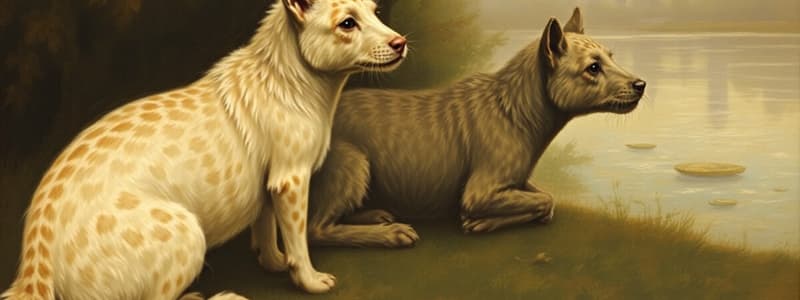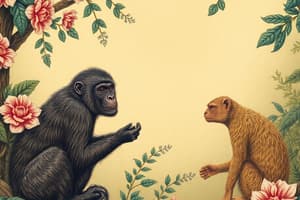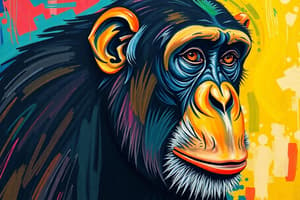Podcast
Questions and Answers
What role did animals primarily serve during the First World War?
What role did animals primarily serve during the First World War?
- Modes of transport and communication (correct)
- Medical support for the injured
- Food supplies for the troops
- Entertainment for soldiers
Which animal was specifically mentioned as a mascot of HMS Glasgow?
Which animal was specifically mentioned as a mascot of HMS Glasgow?
- Tirpitz the pig (correct)
- Flash the dog
- Wojtek the bear
- Warrior the horse
How did cats contribute to naval operations during wartime?
How did cats contribute to naval operations during wartime?
- Carrying messages between ships
- Catching mice and rats (correct)
- Maintaining morale among the crew
- Assisting with navigation
Which famous dog was owned by RAF pilot George Unwin?
Which famous dog was owned by RAF pilot George Unwin?
What was the primary purpose of the soft toys inspired by animals from wartime?
What was the primary purpose of the soft toys inspired by animals from wartime?
What major challenge did cavalry forces face on the Western Front during WWI?
What major challenge did cavalry forces face on the Western Front during WWI?
Which animal was specifically trained to detect poisonous gas during WWI?
Which animal was specifically trained to detect poisonous gas during WWI?
What role did camels play in the military campaigns during WWI?
What role did camels play in the military campaigns during WWI?
What was the function of dogs trained by the French Red Cross on the Western Front?
What was the function of dogs trained by the French Red Cross on the Western Front?
What type of animal served as mascots to uplift morale during WWI?
What type of animal served as mascots to uplift morale during WWI?
What significant award was given to Jet, an Alsatian rescue dog, in 1945?
What significant award was given to Jet, an Alsatian rescue dog, in 1945?
What was one of the primary uses of horses, donkeys, and mules during WWI?
What was one of the primary uses of horses, donkeys, and mules during WWI?
Throughout history, animals have served in various capacities during wars. Which of the following roles has not been historically associated with animals?
Throughout history, animals have served in various capacities during wars. Which of the following roles has not been historically associated with animals?
What was the primary reason cavalry were deemed ineffective on the western front during the First World War?
What was the primary reason cavalry were deemed ineffective on the western front during the First World War?
How important were horses during the First World War despite the ineffectiveness of cavalry?
How important were horses during the First World War despite the ineffectiveness of cavalry?
What was the notable achievement of the pigeon named Gustav during the Second World War?
What was the notable achievement of the pigeon named Gustav during the Second World War?
What was the primary role of camels in the First and Second World Wars?
What was the primary role of camels in the First and Second World Wars?
What type of work were elephants particularly useful for in the Far East during the wars?
What type of work were elephants particularly useful for in the Far East during the wars?
What recognition did Wojtek, the bear, receive during the Second World War?
What recognition did Wojtek, the bear, receive during the Second World War?
What essential service did dogs provide during the First World War?
What essential service did dogs provide during the First World War?
Which animal was protected by law during the First World War due to its vital role?
Which animal was protected by law during the First World War due to its vital role?
What role did mules serve during the Second World War, particularly in the Italian campaign?
What role did mules serve during the Second World War, particularly in the Italian campaign?
What distinguished Judy, the dog, during her time on board HMS Grasshopper?
What distinguished Judy, the dog, during her time on board HMS Grasshopper?
What was a primary characteristic of the animals used during the wars?
What was a primary characteristic of the animals used during the wars?
During which conflict did the blitzkrieg strategy primarily utilize horse-drawn equipment?
During which conflict did the blitzkrieg strategy primarily utilize horse-drawn equipment?
Why were horses and mules especially significant for military operations during both World Wars?
Why were horses and mules especially significant for military operations during both World Wars?
What role did animals play in raising morale among troops during the wars?
What role did animals play in raising morale among troops during the wars?
Flashcards
Animals and War
Animals and War
Animals have been actively involved in wars across history, including transporting soldiers, carrying messages, and providing companionship.
Horses in World War I
Horses in World War I
Millions of horses were used during World War I to transport troops, supplies, and equipment.
Communication Animals
Communication Animals
Pigeons and dogs were trained to carry messages during World War I, enabling communication across battlefields.
Cats on Ships
Cats on Ships
Signup and view all the flashcards
Flash the Dog
Flash the Dog
Signup and view all the flashcards
Animals as Supply Carriers in WWI
Animals as Supply Carriers in WWI
Signup and view all the flashcards
Animal Messengers in WWI
Animal Messengers in WWI
Signup and view all the flashcards
Canaries as Gas Detectors
Canaries as Gas Detectors
Signup and view all the flashcards
Animals as Companions in War
Animals as Companions in War
Signup and view all the flashcards
Camels in Desert Warfare
Camels in Desert Warfare
Signup and view all the flashcards
Dogs as Medical Aid in WWI
Dogs as Medical Aid in WWI
Signup and view all the flashcards
Search and Rescue Dogs in WWII
Search and Rescue Dogs in WWII
Signup and view all the flashcards
Animals and Warfare Throughout History
Animals and Warfare Throughout History
Signup and view all the flashcards
Why was cavalry ineffective in WWI?
Why was cavalry ineffective in WWI?
Signup and view all the flashcards
Horse role in WWI beyond cavalry?
Horse role in WWI beyond cavalry?
Signup and view all the flashcards
Pigeons in WWI & WWII?
Pigeons in WWI & WWII?
Signup and view all the flashcards
Who was Gustav?
Who was Gustav?
Signup and view all the flashcards
Camel role in WWI & WWII?
Camel role in WWI & WWII?
Signup and view all the flashcards
Animals for heavy labor in WWI & WWII?
Animals for heavy labor in WWI & WWII?
Signup and view all the flashcards
Elephant role in war efforts?
Elephant role in war efforts?
Signup and view all the flashcards
Animal mascots' function?
Animal mascots' function?
Signup and view all the flashcards
Who was Wojtek?
Who was Wojtek?
Signup and view all the flashcards
Dog roles in war efforts?
Dog roles in war efforts?
Signup and view all the flashcards
Who was Judy?
Who was Judy?
Signup and view all the flashcards
Dogs' continued role in the military?
Dogs' continued role in the military?
Signup and view all the flashcards
Importance of animals in war?
Importance of animals in war?
Signup and view all the flashcards
Different animal contributions to war?
Different animal contributions to war?
Signup and view all the flashcards
Human-animal partnerships in war?
Human-animal partnerships in war?
Signup and view all the flashcards
Study Notes
First World War Animal Contributions
- Over 16 million animals served in WWI, used for transport, communication, and companionship
- Cavalry forces were large on both sides in 1914, but cavalry charges became difficult on the Western Front due to machine guns.
- Horses, donkeys, mules, and camels carried supplies (food, water, ammunition, medical supplies) to the front line
- Dogs and pigeons carried messages
- Canaries detected poisonous gas
- Cats and dogs hunted rats in trenches
- Animals were used as pets and mascots to boost morale, including monkeys, bears, and lions
- Fox cub was a mascot for No. 32 Squadron in 1918
- Camels carried wounded men in Northwest Frontier of India (1917), Sinai, and Palestine campaigns
- French Red Cross dogs delivered medical supplies on the Western Front (1914)
Second World War Animal Contributions
- Animals continued to be vital, with roles evolving with changing warfare
- Horses and donkeys remained crucial for armies as the backbone of transport
- Even the seemingly invincible German army during blitzkrieg was largely horse-drawn in 1940.
- Pigeons were crucial messengers, with penalties for harming them
- Gustav, an RAF messenger pigeon, delivered the first news from D-Day in over 5 hours
- Camels continued to be used in desert conditions for carrying casualties
- Mules excelled in rocky terrain of Italian campaigns
- Elephants were used for transportation, heavy lifting and construction, like in Hamburg for reconstruction after Allied bombing
- Dogs, especially Alsatians, were trained for search and rescue, like Jet (recovered 150 people from debris), and detection work.
- Dog Judy, aboard HMS Grasshopper, was a mascot, saved lives, and became a Prisoner of War (POW) with the ship
- Dogs were trained in locating mines and explosives
General Animal Roles in Warfare
- Animal roles evolved from previous wars (e.g., elephants for building bridges)
- Animals provided vital modes of transport (horses, mules, donkeys, camels) and communication (pigeons, dogs)
- Animals were essential companions and morale boosters (mascots)
- Animals played a role in detection (canaries for poisonous gas, dogs for explosives, rats)
- Animal welfare was considered important (proper care of animals by British military)
Specific Animal Examples
- Wojtek, a Syrian Brown bear, was a Polish army mascot during WWII, eventually receiving the rank of Private and carrying supplies
- Flash was a fighter pilot George Unwin's dog mascot in WWII.
- Frankenstein the cat, was a favourite on HMS Belfast, particularly for catching rodents
Studying That Suits You
Use AI to generate personalized quizzes and flashcards to suit your learning preferences.





